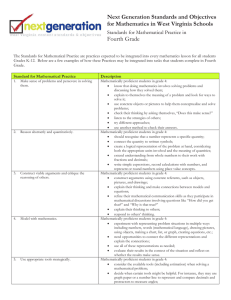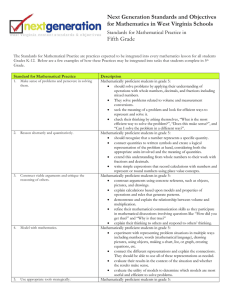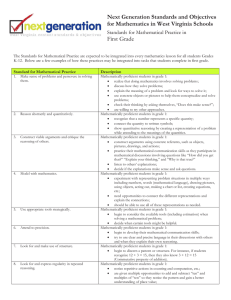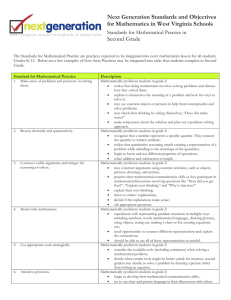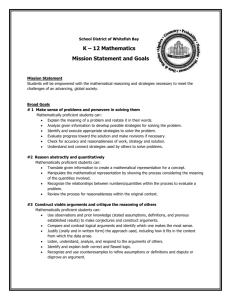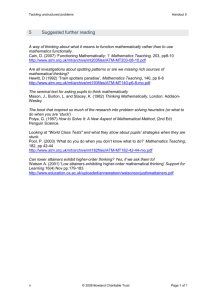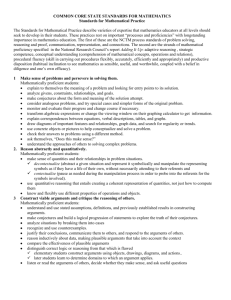CFN Presentation 3
advertisement
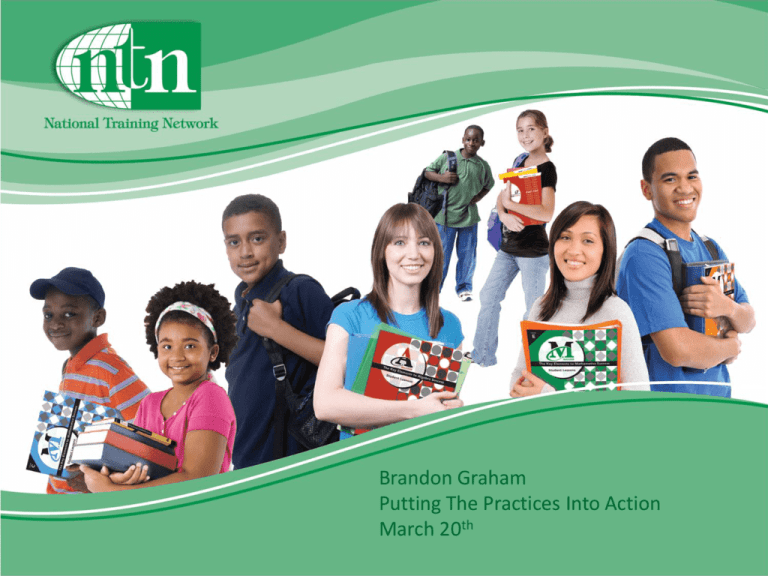
Brandon Graham Putting The Practices Into Action March 20th Focus on the Question There are 420 students who ate lunch in the cafeteria. The following are their lunch choices. 20 pizza 15 55 10 Nuggets Hot Dogs Salad Thursday Question: Two thirds of the students who ordered the hot dog took a ketchup packet, one seventh took a mustard packet and the rest took one of each. How many ketchup packets, and how many mustard packets were taken that day? Tell how you would get the answer. Focus on The Question Discuss with a partner… What is being asked, what data is needed to solve the problem, and what your strategy would be for solving it. Effective questioning should be open ended and require the students to think like mathematicians. • • • • • • • • • • • • • • What is the question asking you to find? What does this mean? How do you know? Can you say it another way? What are the important facts/data? What facts/ data is not needed? Why/ why not? What operation will you use? Why? How do you know which operation to use? Is there another way to solve this problem? Could you have used a picture, diagram or manipulative to solve this? Explain how. How do you know your answer is reasonable? Have you thought of another way this could be done? Do you think we have found the best solution? Justify this thinking. Additional Open Ended Questions can be found on pg. 17 and 25 in Putting The Practices Into Action Standards for Mathematical Practices The focus for this session will be #4 and #5. Independently, review each practice. Be prepared to share your thoughts with the group. CCSS – Standards for Mathematical Practice - #4 SMP4: Model with mathematics. • Mathematically proficient students can apply the mathematics they know to solve problems arising in everyday life, society, and the workplace. In early grades, this might be as simple as writing an addition equation to describe a situation. In middle grades, a student might apply proportional reasoning to plan a school event or analyze a problem in the community. By high school, a student might use geometry to solve a design problem or use a function to describe how one quantity of interest depends on another. Mathematically proficient students who can apply what they know are comfortable making assumptions and approximations to simplify a complicated situation, realizing that these may need revision later. They are able to identify important quantities in a practical situation and map their relationships using such tools as diagrams, two-way tables, graphs, flowcharts and formulas. They can analyze those relationships mathematically to draw conclusions. They routinely interpret their mathematical results in the context of the situation and reflect on whether the results make sense, possibly improving the model if it has not served its purpose. Common Core State Standards for Mathematics – page 6 CCSS – Standards for Mathematical Practice - #5 SMP #5- Use appropriate tools strategically. • Mathematically proficient students consider the available tools when solving a mathematical problem. These tools might include pencil and paper, concrete models, a ruler, a protractor, a calculator, a spreadsheet, a computer algebra system, a statistical package, or dynamic geometry software. Proficient students are sufficiently familiar with tools appropriate for their grade or course to make sound decisions about when each of these tools might be helpful, recognizing both the insight to be gained and their limitations. For example, mathematically proficient high school students analyze graphs of functions and solutions generated using a graphing calculator. They detect possible errors by strategically using estimation and other mathematical knowledge. When making mathematical models, they know that technology can enable them to visualize the results of varying assumptions, explore consequences, and compare predictions with data. Mathematically proficient students at various grade levels are able to identify relevant external mathematical resources, such as digital content located on a website, and use them to pose or solve problems. They are able to use technological tools to explore and deepen their understanding of concepts Pictorial Representation of SMP #4 and #5 *Reread SMP #4 and #5 *Draw a picture, create a diagram or graphic organizer to describe the standard *Include any school/network initiatives that are currently being used in your classroom http://insidemathematics.org/index.p hp/standard-4 Connections to ATLAS 2.0 Video Consider the Following: 1. What were the models being used during this lesson? 2. How did the teacher promote the student behaviors described in SMP #4? SMP #5? 3. Is there anything you would have changed or added to this part of the lesson that would enhance the students’ behavior described in SMP #4 and #5? Our students are better able to… Because as teachers we… Make models to simplify a situation • • • • Identify models that are most efficient for solving specific problems or representing specific math ideas. • • • Analyze models and draw conclusions based on what they see. • • • Model the use of diagrams and drawings to represent problems. Encourage students to create simple diagrams to show problems. Facilitate discussions in which students share multiple ways to model mathematics. Encourage students to revise diagrams as needed. Discuss specific models and their value. (e.g., Why does a 10x10 grid work well to represent a decimal?) Discuss times when a specific model might be appropriate (e.g., Would a 10x10 grid also be appropriate to model percents? Fractions? Why? Ask students to explain why they chose a particular model. Consistently ask for their insights after looking at models. Ask students to interpret models for their classmates (i.e. describe or explain their model). Have students write about what they learned from their model. Equivalent Fractions Activity Magnified Inch Materials: Sentence strips, and rulers Multiplying and Dividing Fractions… How do we develop these skills conceptually? Gallery Walk *Activities or Instructional Strategies to incorporate in your classroom *Open Ended Questions *T Chart with Teacher Look Likes and Sound Likes *T Chart with Student Look Likes and Sound Likes *Report to a poster with your group *Use one colored marker to note your groups ideas on SMP #4 (4, 3, 2, 1) Collaborative Planning…
